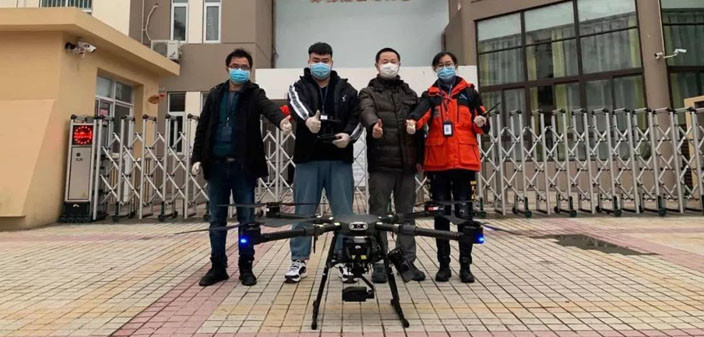As the COVID-19 pandemic continues to spread all around the world and social distancing has become the new normal, countries start to look at how technology can help us during this crisis. Able to safely enter and collect data in environments or conditions dangerous for humans, drones are now a big part of the puzzle and are helping in various ways to mitigate worker shortages and reduce exposure to COVID-19 – one of them being the sanitization of cities.
Digital Aerolus, an autonomous technology provider, developed the Aertos semi-autonomous drones to fly in confined spaces and places where GPS is not available, such as indoors, underground and other places other drones cannot go, by using deep space tech and A.I. Supporting clients in Energy, Mining, Infrastructure, Oil and Gas, and Public Safety industries, the company is now looking into the use of drones for disinfecting surfaces, the interiors of planes and ships, and entire rooms. To this end, Digital Aerolus is investigating two different options for drone-based disinfection: ultraviolet germicidal irradiation (UVGI) and disinfectant fogging.
UVGI is a disinfection method that uses short-wavelength ultraviolet (UVC) to sanitize a surface or an entire indoor area. According to Digital Aerolus, exposure to UVC light with enough intensity and duration destroys the RNA replication mechanism of the virus with +99.9% effectiveness. However, UVC lighting elements are often large and heavy, require significant power a drone can’t handle, and can injure pilots. Therefore, the company is currently working to integrate smaller and more powerful sources of UVC with drones, and using its Mind of Motion Framework (MMF) technology to deploy drones autonomously so that pilots can remain out of harm’s way.
Using a combination of hydrogen peroxide and silver nitrate successfully destroys +99.9% of bacteria and viruses when dispersed as a mist. This is one of the ways hospitals and other facilities use the disinfectant fogging technique to decontaminate indoor areas. While drones mounted with disinfectant systems can fly outdoors to fight COVID-19’s contamination, Digital Aerolus wants to bring the fight indoors. The company believes “chemical disinfectant canisters mounted on stable indoor drones may prove to be an indispensable weapon in combating the Coronavirus indoors” and is now testing ways to mount and deliver disinfectant systems with its stable indoor industrial drones.
To help fight the pandemic, other companies sought out the use of drones originally designed to spray pesticides for agricultural applications and adapted them to spray disinfecting chemicals in some public spaces and on epidemic prevention vehicles traveling between impacted areas. On February 4, DJI pledged almost US $1.5 million in aid to help contain the outbreak and adapted the Agras series of agricultural spraying drones to spray disinfectant in potentially affected areas.
“Assisting on the containment of a disease, while ensuring safety to personnel, was very difficult to do in the past,” said Romeo Durscher, Senior Director of Public Safety Integration at DJI. “This was a complete grassroots movement. Users inspired us to take action, and it was worth the effort. It embodies the DJI spirit, where anyone with access to these new tools can help improve their environment and help society.”
In China, XAG Technology, DJI Agriculture, China Agricultural Machinery Distribution Association, China Agricultural University Research Centre for Medical Equipment and Application Technology worked together to publish a series of operational guidance regarding the use of drones for aerial spray and disinfection. As of February 28, 2020, a total of 370 professional teams with over 2,600 XAG agricultural drones have voluntarily joined the disinfection operation, covering an area of 902 million square meters in China’s 20 provinces. Also, by flying for up to two hours, the drones from Fly Dragon Drone Tech, a developer of agricultural UAV systems, can spray disinfectant over more than 13 square kilometers in one flight, which is equivalent to four hours of work for four cleaning staff.
In South Korea’s city Daegu, the center of South Korea's coronavirus outbreak, private drone companies also turned to drones to help disinfect public places at the local government’s request. A single drone can load around 2.5 gallons of disinfectant and spray an area of up to 105,000 square feet in around 10 to 12 minutes. The Municipal Corporation in Indore, India’s cleanest city, also hired two drones to fight off the virus. These drones take off with 16 litters of chemicals in each flight and return after 30 minutes having sprayed chemicals in an area spanning 4–7 miles.
Other than using drones to sanitize cities, delivery drones can help to transport medical samples and quarantine supplies to fight the coronavirus. Vaughan-based Drone Delivery Canada (DDC) is in dialogue with the federal government to review drone regulations to try and set up drone delivery operations.
“The current situation is an ideal use-case for our proven drone logistics solution to limit person-to-person contact; bring needed medical and pharmaceutical supplies to remote, rural and suburban communities; transport blood samples to laboratories for testing and deliver other relevant supplies needed for Canada to effectively manage the current situation,” said Michael Zahra, President & CEO of DDC.
Antwork, a Terra Drone group company, flew a drone from the People’s Hospital of Xinchang County to the disease control center of Xinchang County, increasing the speed of transport by more than 50% compared to road transportation and reducing contact between samples and personnel.
















Comments